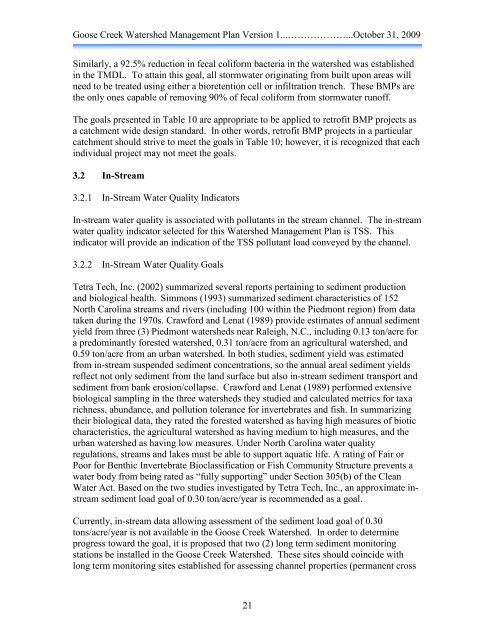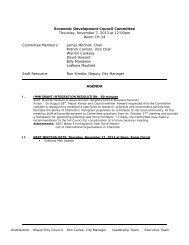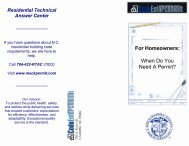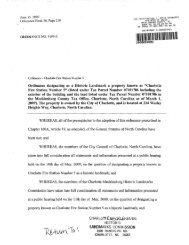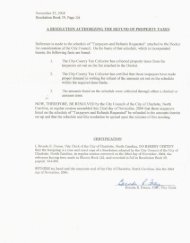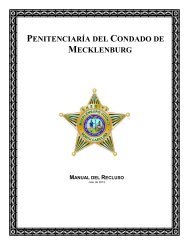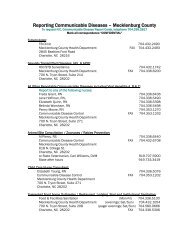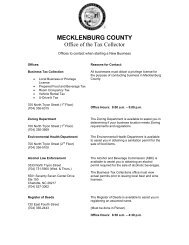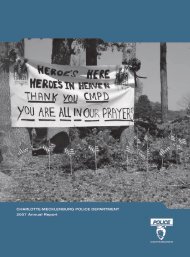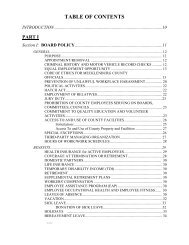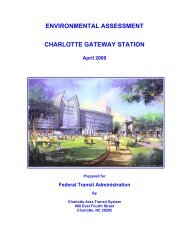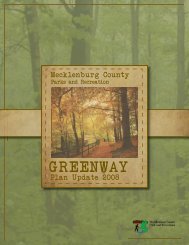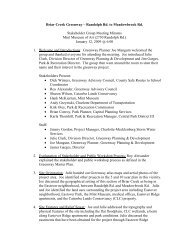Goose Creek Watershed Management Plan Version - Charlotte ...
Goose Creek Watershed Management Plan Version - Charlotte ...
Goose Creek Watershed Management Plan Version - Charlotte ...
Create successful ePaper yourself
Turn your PDF publications into a flip-book with our unique Google optimized e-Paper software.
<strong>Goose</strong> <strong>Creek</strong> <strong>Watershed</strong> <strong>Management</strong> <strong>Plan</strong> <strong>Version</strong> 1...………………...October 31, 2009<br />
Similarly, a 92.5% reduction in fecal coliform bacteria in the watershed was established<br />
in the TMDL. To attain this goal, all stormwater originating from built upon areas will<br />
need to be treated using either a bioretention cell or infiltration trench. These BMPs are<br />
the only ones capable of removing 90% of fecal coliform from stormwater runoff.<br />
The goals presented in Table 10 are appropriate to be applied to retrofit BMP projects as<br />
a catchment wide design standard. In other words, retrofit BMP projects in a particular<br />
catchment should strive to meet the goals in Table 10; however, it is recognized that each<br />
individual project may not meet the goals.<br />
3.2 In-Stream<br />
3.2.1 In-Stream Water Quality Indicators<br />
In-stream water quality is associated with pollutants in the stream channel. The in-stream<br />
water quality indicator selected for this <strong>Watershed</strong> <strong>Management</strong> <strong>Plan</strong> is TSS. This<br />
indicator will provide an indication of the TSS pollutant load conveyed by the channel.<br />
3.2.2 In-Stream Water Quality Goals<br />
Tetra Tech, Inc. (2002) summarized several reports pertaining to sediment production<br />
and biological health. Simmons (1993) summarized sediment characteristics of 152<br />
North Carolina streams and rivers (including 100 within the Piedmont region) from data<br />
taken during the 1970s. Crawford and Lenat (1989) provide estimates of annual sediment<br />
yield from three (3) Piedmont watersheds near Raleigh, N.C., including 0.13 ton/acre for<br />
a predominantly forested watershed, 0.31 ton/acre from an agricultural watershed, and<br />
0.59 ton/acre from an urban watershed. In both studies, sediment yield was estimated<br />
from in-stream suspended sediment concentrations, so the annual areal sediment yields<br />
reflect not only sediment from the land surface but also in-stream sediment transport and<br />
sediment from bank erosion/collapse. Crawford and Lenat (1989) performed extensive<br />
biological sampling in the three watersheds they studied and calculated metrics for taxa<br />
richness, abundance, and pollution tolerance for invertebrates and fish. In summarizing<br />
their biological data, they rated the forested watershed as having high measures of biotic<br />
characteristics, the agricultural watershed as having medium to high measures, and the<br />
urban watershed as having low measures. Under North Carolina water quality<br />
regulations, streams and lakes must be able to support aquatic life. A rating of Fair or<br />
Poor for Benthic Invertebrate Bioclassification or Fish Community Structure prevents a<br />
water body from being rated as “fully supporting” under Section 305(b) of the Clean<br />
Water Act. Based on the two studies investigated by Tetra Tech, Inc., an approximate instream<br />
sediment load goal of 0.30 ton/acre/year is recommended as a goal.<br />
Currently, in-stream data allowing assessment of the sediment load goal of 0.30<br />
tons/acre/year is not available in the <strong>Goose</strong> <strong>Creek</strong> <strong>Watershed</strong>. In order to determine<br />
progress toward the goal, it is proposed that two (2) long term sediment monitoring<br />
stations be installed in the <strong>Goose</strong> <strong>Creek</strong> <strong>Watershed</strong>. These sites should coincide with<br />
long term monitoring sites established for assessing channel properties (permanent cross<br />
21


